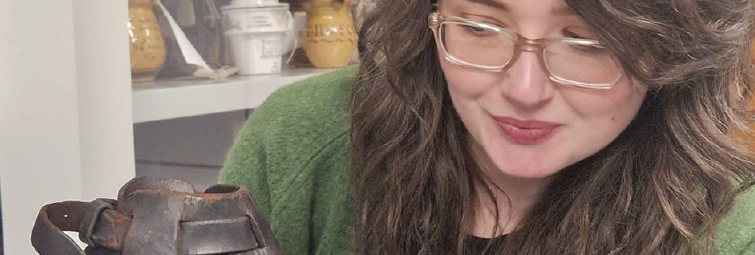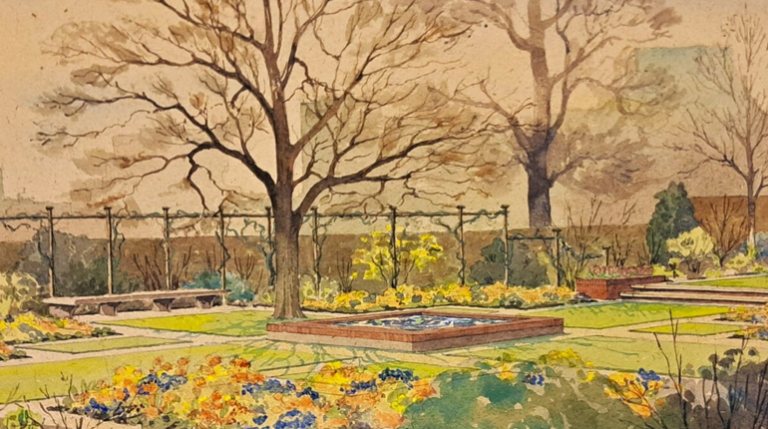51 Voices: Discovering Treasures
-
Author
- Joe
-
Published Date
- December 14, 2021

In January 2021, The MERL embarked on 51 Voices, a year-long project celebrating the museum’s seventieth anniversary. Throughout the year we have been working with a range of writers, artists and communities to give contemporary Voice to fifty-one objects and archives within The MERL collection connected in myriad ways to our founding year.
In this final monthly roundup of 51 Voices, join us as we reflect on the work of six artists with different creative communities. Discover how several of the fifty-one objects were given Voice in ways that explore their ongoing resonance in our lives and changing world today.
Queer Lands
A beautiful collaborative publication, Queer Lands was created by twelve participants; a small, intimate group of queer and trans people interested in exploring the land, place and belonging in rural contexts. Their conversations, exploring the interplay between queer identities and relationships to the land, focused on a text from The MERL’s archive and two queer and resistant texts around bodies in the landscape, which were chosen in contrast to the voices of Object #20 Farmer’s Weekly.
Writer and facilitator Oren Shoesmith explained:
Using the language of all three texts, we wrote poetry and elaborated our feelings together, weaving hope of a new archive which can contain us. This Queer Lands publication acts as memorial to some of these thoughts. In it are erotic longings for a land that leads into the wilderness. I hadn’t realised how necessary conversations around rural contexts and queer identities felt or how lacking they’d been in my own life up until that moment.
Mysterious Objects
A collection of descriptive writings responding to The MERL collection, Mysterious Objects was produced by local primary school students with local children’s author, Clare Rees. Ten objects linked to the museum’s founding year, 1951, were chosen either because of their uncertain history, or their potential as an interesting source for a story (real or imagined).
During week one of the project, a little boy from one of the classes involved dug up an object in his garden during lockdown. Described to us by his mum as a ‘weird spoon’, he had recognised the Festival of Britain symbol from the Object #9 Horse Brass he looked at during Clare’s session. His family, whole class and we folks at The MERL were delighted when our curator confirmed his discovered treasure as a Festival of Britain tea caddy spoon.
HaikuMoo
Adam Stead, an artist using museum objects, agricultural materials and working rural landscapes to engage people partnered with students from Redlands School and participants in The MERL’s public programme to create HaikuMoo. This interactive website gives instructions on how to draw a dairy cow, while learning about dairy breeds and terminology. Using Object #20 Farmers Weekly as a starting point, Adam’s work was also featured in the June 2021 issue of Farmers Weekly itself.
Adam reflected:
The beauty of this instructional method of teaching using Jon Lockhart’s experimental use of Thing-Link software, is that this workshop is expandable in content; repeatable in format and widely accessible – (everyone) really loved the interactivity. (Students) were delighted to each receive a copy of a recent magazine, kindly donated by Farmers Weekly, especially for the workshops.
Landscape = Health + Wellbeing
Reading’s Reside Dance collaborated with the Earth Living Festival and the Royal Berkshire Hospital to produce Landscape = Health + Wellbeing. Workshops were designed and delivered, and a film was created taking Object #25 National Parks as inspiration.
The film captures a connectedness with the environment that we can discover from being outdoors, and how this can draw upon our strong sense of inner connection.
Dancer Emma explained:
For me, [this] is about connection […] connection to other people […] connection to our environment. Get outside, take in what you see and everything around us. Thank you to everyone involved for making such a wonderful space.
The work on this project focused on meeting the NHS Five Steps to Mental Wellbeing as an effective way of assessing what had been achieved.
Pavlo Kerestey’s work
Visual artist Pavlo Kerestey took Object #23 Ration Book as a starting point, linking this to his research of The MERL Evacuee Archive. Pavlo explored texts, writing, drawings and paintings related to the theme of migration in order to develop workshops. Participants were invited to chose objects representing their own journey to Reading. They explored these objects’ significance through creativity, producing graphic block shadow drawings to reflect upon and represent their own experience.
A 51 Voices Late – or, what we’re doing instead
To celebrate and share all these creative collaborations, and to wrap up our 70th anniversary year, The MERL had started planning for a 51 Voices themed Museum Late. However, we made the considered and difficult decision not to proceed with the in-person event due to COVID concerns.
So, in the New Year, thanks to support from Reading University Arts Committee, we will create a film reflecting on this past year of 51 Voices. We are working on this with Reading-based Culture Mix Arts to explore steel pan music from the 1950s, to inspire and create a new composition to perform for the film. This steel pan band has its roots deeply connected to 1951 and the introduction of steel pan to the UK. The first live steel band performance in the UK took place at the 1951 Festival of Britain, as the Trinidad All Steel Percussion Orchestra took to the stage of The South Bank Centre.
With many thanks to all the artists and communities who worked together during lockdown and challenging times to produce such extraordinary co-created work. And thanks to the University of Reading Arts Committee, Arts Council England, the Government’s Culture Recovery Fund, and to our many volunteers and colleagues across University of Reading’s Museums and Special Collections Services, for making all this possible.





